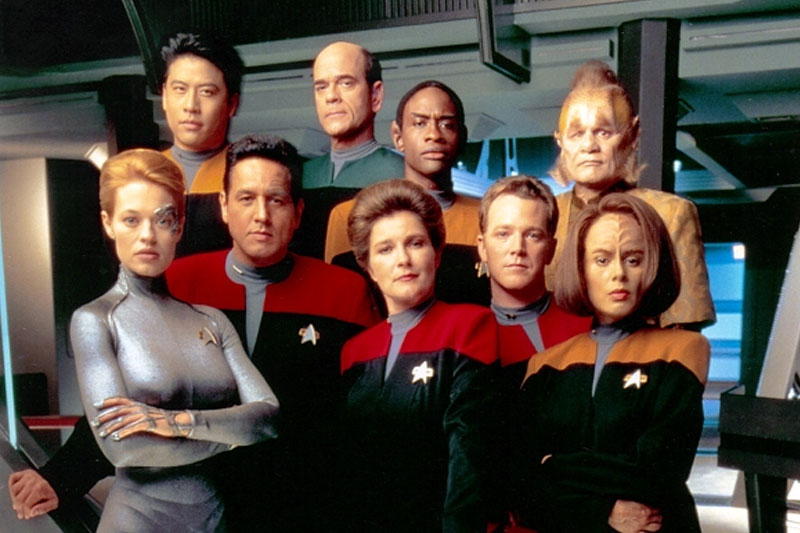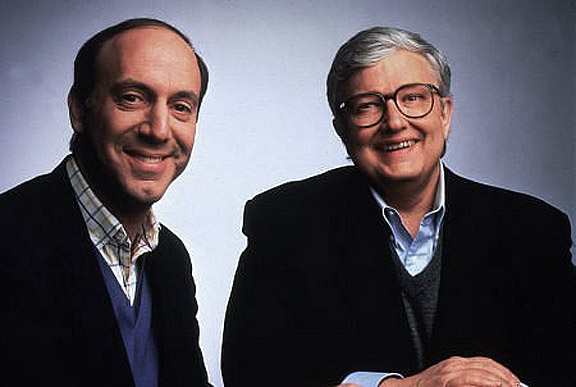Whatever you say against JJ Abrams’ Star Trek Into Darkness—and I’d say plenty—you can’t claim it lacks purpose. Like Abrams’ first entry, it seems dedicated to stripping Trek of its cockeyed optimism, its sense of last-frontier
adventurism, and its progressive worldview, and letting the remainder marinate in testosterone and male supremacy politics. So, all the qualities that made Star Trek special—the deep, silly, starry-eyed, predictable,
always-inclusive things that sparked a half-century, trans-global love affair? Gone. In their place: a white man-centered Starfleet command. Random T&A.
Plot-poaching from old Treks. The Prime Directive, scrunched. The Enterprise—a
starship!—hiding from primitive aliens underwater.
As we mourn Abrams’ macho Trek obliteration, it’s a good time to revisit
Voyager, at once the most Star Trek-ian of accomplishments and the most despised object of fanboy loathing in the
franchise’s nearly 50-year history. From 1995-2001, it offered American audiences something never
seen before or since: a series whose lead female characters’ agency and
authority were the show. It was a rare heavy-hardware science
fiction fantasy not built around a
strong man, and more audaciously, it didn’t seem to trouble itself over how
fans would receive this. On Voyager, female authority was assumed and unquestioned;
women conveyed sexual power without shame and anger without guilt. Even more so
than Buffy, which debuted two years later, it was the most feminist show in
American TV history.
Voyager wasn’t
some grrl power screed in Starfleet regalia. The ideas and emotions it explored
were very much in the Star Trek wheelhouse; it just came at
them from a fresh–and to some viewers, off-putting–angle. Led by Kathryn
Janeway (Obie-Award-winner Kate Mulgrew), the first female Trek captain
to carry a series, Voyager brought us some of the most
convulsively inventive humanist science fiction this side of early Stephen Moffat-era Doctor Who.
Set in the 2370s, Voyager episodes ping-ponged wonderfully
between genres and modes. We got a revolution fought in the safety of dreams (“Unimatrix Zero”) and a
metaphor-rich engagement with childhood violence and memory (“The Raven”). Some episodes spotlighted the kinds
of spiritual engagements that frequent Voyager scripter Ronald
D. Moore would import whole-hog to his post-9/11 remake of Battlestar
Galactica.
And yet to this day, Voyager is often despised in the most
grotesque terms, as a Star Trek apostate. The loathing isn’t
as severe as it was when the show went off the air, and Trek Today published
an ongoing “mock trial” titled “The Court Martial of Captain Kathryn
Janeway.” But while fan
consensus seems to have swung around during the last 18 years, albeit with the
agility of an aircraft carrier course-correcting, Voyager still
inspires loathing so deep that whole Youtube channels may be required to feed
it. As recently as October 2012, the sci-nerd bellwether site Den
of Geek asked “Why do Star Trek fans Hate Voyager?” as if the assumption were so widely
accepted as to stand unquestioned. The article hit the carotid artery of
fanboy animus when it suggested that “the hatred is mostly about those first
two words in the title. After all, what is Star Trek?” The
self-evident answer: not Voyager.

Show creators Rick Berman, Michael Piller and Jeri Taylor clearly asked
themselves the same thing. They breathed new life into a moribund franchise by
taking the whole “where no man has gone before” thing and really running with
it. As the critic Alan Sepinwall reminds us, a great show teaches us how to watch it.
With Voyager, the fanboys would have to learn how to live without a default male lead to identify with, a hero in Kirk/Picard/Riker mode. They would have to learn to identify beyond gender, and the challenge didn’t end at the captain’s chair. Along with Mulgrew’s fascinating, maddening Captain
Janeway—bullheaded; childless by choice; at once doctrinaire and
impulsive—the showrunners gave us a prickly/brilliant Chief Engineer named
B’Elanna Torres (Roxann Dawson) struggling with her biracial half-human
Hispanic, half-Klingon identity. By season four, ship botanist Kes
(Jennifer Lien) left Voyager; her screentime was filled with a
103-episode-long redemption tale about a bemused, tragic and insanely svelte
de-assimilated Borg called Seven of Nine (Jeri Ryan).
The show also expected viewers to spend time with an Asian Operations
Officer (Garrett Wang), a half-black, half-Vulcan tactical officer (Tim Russ),
and a Native American First Officer (Robert Beltran) before finally meeting the
crew’s significant male Caucasians, none of whom fit the traditional Buck
Rogers/Flash Gordon/Luke Skywalker/James Kirk descriptors. One was the
hilariously arch medical hologram played by Robert Picardo. The other was
helmsman Tom Paris (Robert Duncan McNeill).
In the context we’re exploring
here, Paris is particularly fascinating. In theory, he was there carry the flag
for straight male heroic signifiers, but there were clues that he was actually
there to tweak people’s expectation that science fiction adventures had to put
a straight white guy at center-stage. The character spent his off-time saving helpless women in his virtual
reality simulation of ‘30s SF serials, Captain Proton — a
sweet spoof of the brand of outer-space swashbuckling that Roddenberry
embraced on the original Star Trek, and that continued, in a more
intellectualized way, on The Next Generation.
Having devastated the usual gender order of Trek product,
Bergman, Piller and Taylor then demolished the idea of what their show would do, by putting its characters, and by
extension its viewers, in a defensive crouch.
This series wasn’t built around officers that could project military force,
which is itself essentially masculine, whenever they needed to, and expect to
be backed by the full faith and credit of Starfleet, even when they’d done
something wrong or stupid. They were isolated, deprived of the usual
political-military support network that made all other Trek adventures,
including Deep Space Nine, so comforting to fans.
The story began when the USS Voyager was hurled by an energy wave 70,000
light-years, to the butt end of the universe. After that, her mission was
simplified: aim Earthwards for a 75-year journey home that the crew was
unlikely to survive.
And that was it. No Starfleet hijinks, no strutting around the galaxy, just
150 or so people stuck together for life. Voyager often feels
less like a continuation of Trek as we know it than a
challenge in the form of a question: “So you think you know what Star
Trek is?” The series is an anti-action, existential feminist
family drama, shot through with a persistent melancholy that reflects the
crew’s desperation.
Yes, it’s still Star Trek, but the sheer unfamiliarity of the crew’s
predicament was disorienting. This far end of space is haunted by the violence of war. Mass violence
carries more weight here, arguably, than in any other incarnation of Star Trek,
and it’s no stretch to suggest that the show’s tragic attitude toward war comes
out of its female-centered perspective.

Here, military violence is portrayed not as a stereotypical male general might
see it, but as it might be viewed by the equivalent of a diplomat, or a
representative of the Red Cross, or the United Nations. It’s a catastrophic
event that engulfs whole civilizations, displaces whole species. It causes
wounds that don’t heal for generations, or starts new conflagrations. Voyager constantly meets races and species that are starting a war or recovering from
one, and keeps stumbling upon the ghostly remnants of obliterated
civilizations. This strain of sadness is so persistent that the show often
feels like gentle critique of the military-macho strain that ran through the
original series, the films based on it, as well as many episodes of the more
self-aware The Next Generation. (David Gerrold, screenwriter of “The Trouble With Tribbles”, has said that series creator Gene Roddenberry modeled James T. Kirk on John F. Kennedy, who was socially liberal but also a military hawk and a womanizer.)

The episodes’ plots did little to reassure viewers who felt unmoored from
the Trek they knew and loved, but the best of them could stand
toe-to-toe with the most provocative science fiction in TV history. In “Night”, the crew meets black-skinned aliens who live in eternal
darkness and would prefer to remain that way. The Lovecraftian “Species 8472”
haunts several episodes, and is so un-anthropomorphically bizarre and deadly
that it’s best to deal with them by running the other way. Other episodes deal
with spiritual crises — with the question of what, if anything, happens after
we die, and whether there is a God, or gods, or some other higher intelligence
keeping watch over the material world. In “Mortal Coil”, upbeat ship chef
and Morale Advisor Neelix (Ethan Phillips) loses the faith in the afterlife
that lets him cope with his species’ genocide. When he dies and is resurrected
by Borg technology, he realizes there is nothing after death but…nothing.
“Barge of the Dead”, meanwhile, finds B’Elanna Torres suffering visions of the
Klingon version of Hell accompanied with her mother, damned because of
B’Elanna’s inability to accept herself.
In a lighter vein, the “Fair Haven” episode threw viewers out of SF
entirely and into ‘Ireland’, courtesy of the ship’s virtual reality holodeck.
Captain Janeway meets–and modifies to taste–a hot Irish hologram that she
utilizes for some carnal R&R. The episode uses its SF tropes to
correct assumptions of female guilt and sexual self-pleasure, specifically the
idea that it’s impossible for a woman to sleep with a man and not become
romantically involved.

When Voyager was firing on all cylinders, stories this
rich popped up every week. And as mentioned, at the heart of many of them
was the ex-Borg named Seven of Nine. With her ice blond hair frozen in a
‘50s up-do, her curves packed into a series of absurdly tight space-leotards,
and a manner of often hilarious extreme hauteur, Seven of Nine was a sexually
remote Hitchcockian fatale in SF drag, and one of the most richly imagined
characters in TV history. Seven’s backstory is that the Borg stole her when she was only six,
quashing her identity and filing her body with cybernetic implants that link
her to the Borg hive-mind. Captain Janeway liberates her from the Borg in
“Scorpion: Part 2” and spends the rest of Voyager helping her
regain her individuality in increments, switching deftly between the roles of
therapist, role model, teacher and mother. Seven earns her redemption
through the storms of multiple personality disorder, body dysmorphia, trauma
responses, and intimacy terrors. In other words, a thinly veiled, story of
child abuse survival, and one that’s proving to be a great inspiration to
survivors now, in the real world.
Watching Voyager today still a delight, but it’s also illuminating in ways
that aren’t so delightful. It’s impossible not to feel crestfallen at the
systemic de-evolution that we’ve seen since. This supposedly great
age of TV has give us many fascinating artistic innovations, but its
representation of women is problematic at best. If you look at most of many
of the high watermarks of the last two decades — shows such as The
Sopranos, The Shield, Mad Men, Breaking Bad, Boardwalk
Empire, Justified and Sons of Anarchy — they’re
all mainly concerned with alpha males struggling to hold onto their privilege
during changing times. That’s only a “universal” story if you agree
that straight white males really are the universe.
In the meantime, the self-determined
female leads of Voyager — and Buffy, and a
handful of other unusual genre series — have been supplanted by strong female
characters that aren’t really as strong as they seem. As former Salon TV
critic Heather Havrilesky noted in her New York Times piece, “TV’s New Wave of Women: Smart, Strong,
Borderline Insane”, even our
richest female leads come with a soupçon of instability. “I don’t mean
complicated, difficult, thorny or complex,” she writes. “I mean that
these women are portrayed as volcanoes that could blow at any minute. Worse,
the very abilities and skills that make them singular and interesting come
coupled with some hideous psychic deficiency.”
And so the title character
of Nurse Jackie is a pill head. Homeland‘s Carrie
Mathison is a bipolar wreck. The reporter Zoe Barnes on House of Cards is
a semi-sociopath who sleeps with a powerful man twice her age to get scoops.
The female characters on The Newsroom feel like a man’s
condescending fantasy of how smart professional women acted thirty years ago,
only needier. The Following demands that Claire
Matthews either beg her serial killer ex-husband not to gut her, or her
alcoholic wreck of an ex-lover to save her.
Illness, mental disarray and hormonal imbalance are, of course, the
traditional weapons wielded to cut the threat level posted by intelligent,
aggressive female heroes.
Flying in the face of that are the women of Voyager. No matter
what psychological damage or tragic history they had to overcome, they always
were what they were, not what they suffered from. What Trek fans
who dislike Voyager are feeling might not actually be hate. It
may be more like an aggravated fear verging on outright panic that a type of TV
heroine that that they thought had been eliminated or marginalized in the years
since the series ended won’t be forgotten, and could rise again.
What they’re
feeling is the terror of potential.
Ian Grey is a New York writer whose work on visual arts, music, and identity politics have been published by Press Play, Baltimore City Paper, Lacanian Ink, The Prague Post, The Perfect Sound, Salon, Gothic.net, Smart Money, Time Out New York, and other forums. A novel on trauma, sex work and sound is now being shopped.












